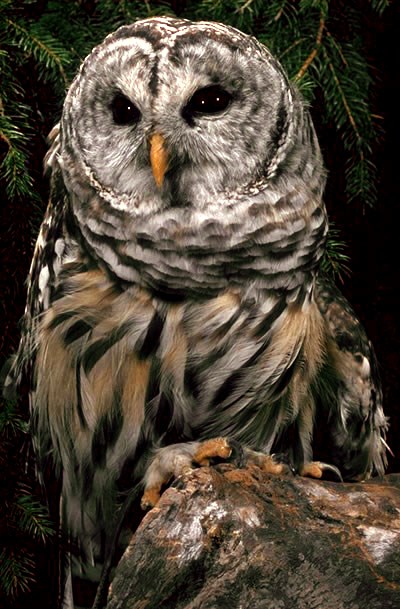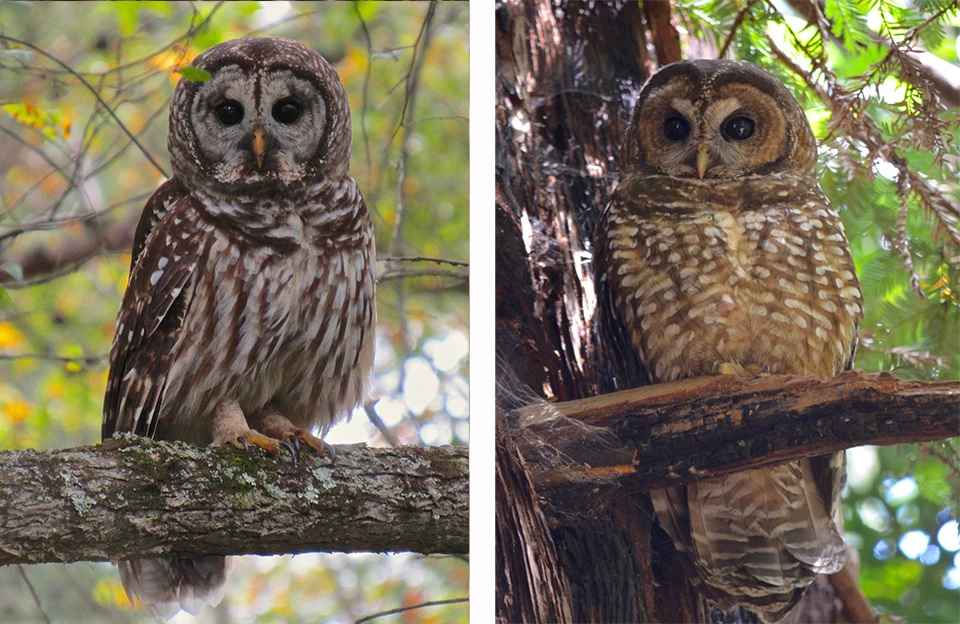Last updated: March 30, 2020
Article
Barred Owls in Marin County

California Academy of Sciences / Dr. Lloyd Glenn Ingles
Importance
Barred owls (Strix varia) recently expanded into the forest communities of Marin County and may be negatively impacting the federally threatened northern spotted owl (Strix occidentalis caurina).
Monitoring Program
The National Park Service (NPS) monitors the northern spotted owl population on federal lands in Marin County. During surveys, the NPS also records the presence of barred owls and other potential threats.
NPS has been monitoring the spotted owl population at Point Reyes National Seashore, Golden Gate National Recreation Area, and Muir Woods National Monument since 1998 as part of a long-term monitoring program. Researchers conduct surveys during the spotted owl breeding season (March - August) to determine if spotted owls are present and successfully reproducing. Additionally, in 2012, one of the barred owls at Muir Woods was fitted with a radio transmitter so that biologists could track its movements. The owl was monitored until its eventual death in 2015 in Muir Woods.
Learn More: Northern Spotted Owl Monitoring in the San Francisco Bay Area
Status and Trends
Through the spotted owl monitoring program, researchers documented the first known barred owl on federal lands in Marin County in 2002, the first pair in 2005, and the first successful breeding in 2007, all in Muir Woods National Monument.
Since 2002, researchers have detected barred owls in Muir Woods, Olema Valley, and near Bear Valley in Point Reyes. The first successful breeding of barred owls in Marin took place within a historic spotted owl territory of high quality redwood habitat in Muir Woods. Besides the pair at Muir Woods, all other barred owl detections in Marin were of single birds until another pair was detected in Olema Valley in 2019. In 2020, a pair was heard in Mill Valley.
Detection of individuals and mating pairs of barred owls have fluctuated over the years, as has the detection of spotted owls. In 2015, the breeding barred owl pair at Muir Woods and two individuals previously inhabiting Olema Valley and Point Reyes were not detected during surveys. The following year, spotted owls were found back in these historic territories. Although Muir Woods had historically contained two spotted owl territories, they had not been detected within the boundaries of Muir Woods since 2010. Nesting success has continued to fluctuate.
In fall of 2017, barred owls were again detected at Muir Woods and Olema Valley after a two-year absence, and in 2019 three barred owls were detected at the Olema Valley site. Future spotted owl monitoring surveys will continue to document spotted owl occupancy and reproduction in these areas.

Left: © kevinemetcalf / Photo 4624033 / October 2015 / iNaturalist.org / CC BY-NC
Right: NPS / Taylor Ellis
Public Involvement in Conservation
Human activities, including those of land managers, scientists, and park visitors, can have an impact on the land and wildlife. Because barred owls may be exerting pressure on spotted owls, it is especially important for humans to limit their own impacts. While watching owls, follow these guidelines to ensure that you do not unintentionally compromise the safety and nesting success of the spotted owl:- Quietly observe owls at a distance with binoculars or spotting scope from trail corridors.
- Limit your time with the owl(s) and do not share the location of the nest site with others to avoid excessive activity in the core nest area, which could lead to nest failure.
- Leave immediately if the owls are mobbed by other birds to avoid attracting predators to the owl’s location. Also leave the area if your presence seems to be affecting or changing the behavior of the owl.
- Differentiating between barred owls and spotted owls can be difficult, so please follow these guidelines when observing all owls.
- If you discover a spotted owl or barred owl anywhere in Marin County, please write a complete description of the observation, including time and location, and submit to a spotted owl contact with the San Francisco Bay Area Inventory & Monitoring Network.. Photographs are helpful but photographing owls should be limited to daylight hours, and owls should not be approached for the purpose of photography.
- It is ethically unacceptable or illegal to use calls or taped playbacks to attract owls, to stake out or flag nest locations, or to violate area closures or activity restrictions.
For a more extensive “code of ethics” for wildlife watching, visit this list compiled by The American Birding Association.
If you discover a spotted owl or barred owl anywhere in Marin County, you can help biologists’ tracking efforts by sending a message with the details of your observation (e.g. time, date, location) to a spotted owl contact with the San Francisco Bay Area Inventory & Monitoring Network.
Additional Resources
Contact Information
Links
San Francisco Bay Area Inventory & Monitoring Network - Northern Spotted Owls
Pacific Coast Science & Learning Center - Northern Spotted Owls
U.S. Fish and Wildlife Service Species Profile - Northern Spotted Owl
The 2008 Final Recovery Plan discusses the barred owl as a significant threat.
Summary by San Francisco Bay Area Inventory & Monitoring Network, February 2009. Updated by Taylor Ellis and Maritte O'Gallagher, March 2020.
